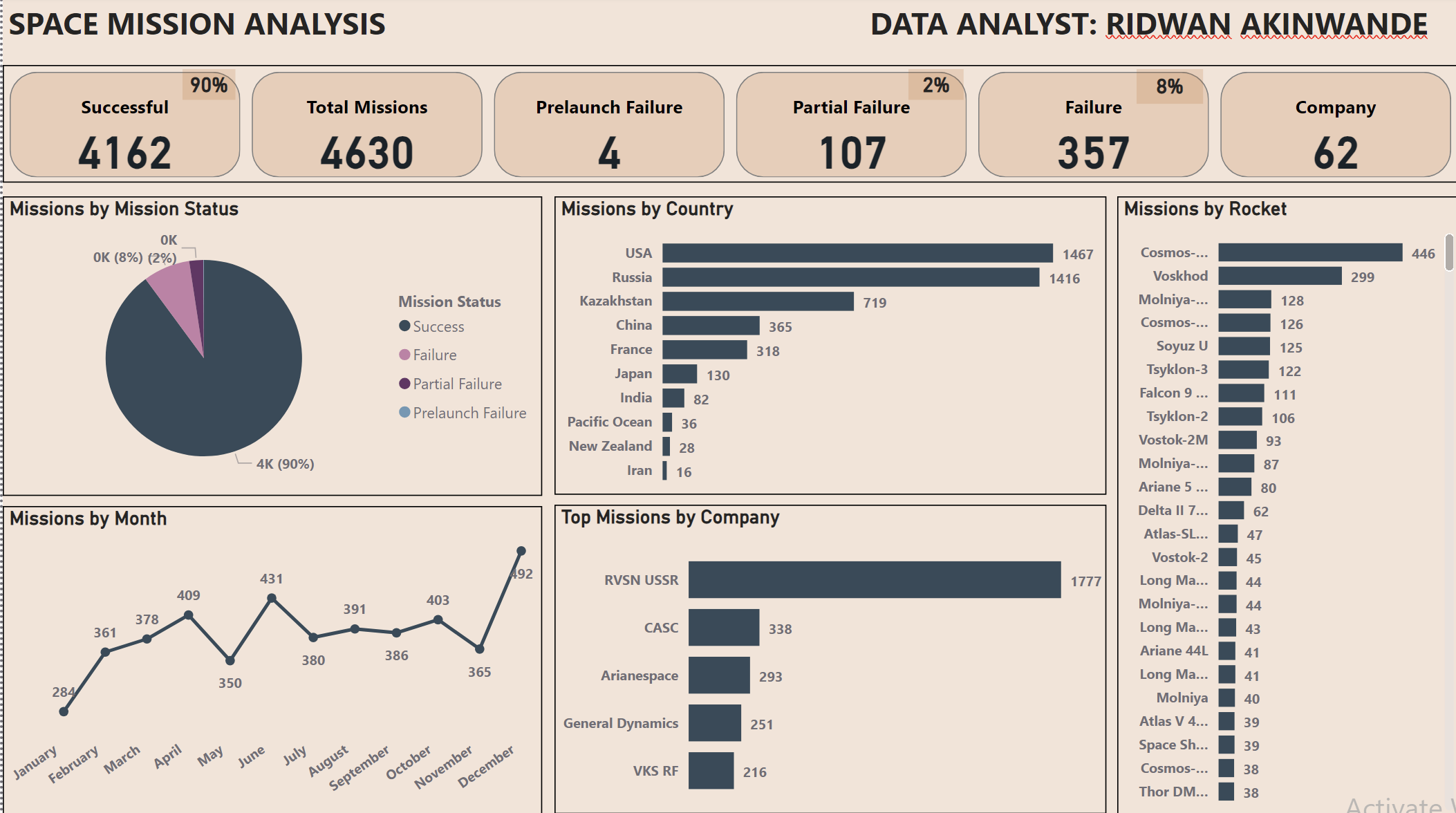Space Mission Analysis
 Ridwan Akinwande
Ridwan AkinwandeThis comprehensive report provides key insights into space missions conducted from 1957 to 2022, leveraging data analysis through Microsoft Power Business Intelligence, and the data source is Quantum Analytics. The following highlights key metrics, trends, and notable contributors to the space mission landscape.

Key Findings:
1. Mission Outcomes: Success emerged as the dominant outcome, with 4,162 successful missions, followed by Failure at 357, Partial Failure at 107, and Prelaunch Failure at 4. Success accounted for a substantial 89.89% of total missions, while failure constituted 8%, and partial failure contributed 2%.
KPIs:
Success Missions: 4,162
Failure Missions: 357
Partial Failure Missions: 107
Prelaunch Failure Missions: 4
2. Global Distribution of Missions: The United States led in total missions with 1,467, showcasing a 9,068.75% difference from Iran, which had the lowest total missions at 16. The U.S. accounted for 32.05% of total missions. Across all ten countries, mission counts ranged from 16 to 1,467.
KPIs:
Total U.S. Missions: 1,467
Total Iranian Missions: 16
U.S. Contribution to Total Missions: 32.05%
3. Rocket Contributions: Cosmos-3M (11K65M) led with 446 total missions, followed by Voskhod and Molniya-M/Block ML. Cosmos-3M (11K65M) accounted for 9.63% of total missions. Among 370 rockets, total missions varied from 1 to 446.
KPIs:
Cosmos-3M (11K65M) Missions: 446
Total Rocket Count: 370
Cosmos-3M (11K65M) Contribution to Total Missions: 9.63%
4. Monthly Mission Trends: December recorded the highest total missions at 492, surpassing January by 73.24%. December constituted 10.63% of total missions. Across all twelve months, mission counts ranged from 284 to 492.
KPIs:
December Missions: 492
January Missions: 284
December Contribution to Total Missions: 10.63%
5. Agency Contributions: RVSN USSR led with 1,777 total missions, exhibiting a 722.69% difference from VKS RF, which had the lowest total missions at 216. RVSN USSR accounted for a significant 61.81% of total missions. Across all five agencies, total missions ranged from 216 to 1,777.
KPIs:
RVSN USSR Missions: 1,777
VKS RF Missions: 216
RVSN USSR Contribution to Total Missions: 61.81%
Recommendations for Stakeholders:
Success Optimization: Emphasize strategies to enhance mission success rates, potentially through technology upgrades and rigorous testing protocols.
Global Collaboration: Encourage international collaboration in space missions to leverage diverse expertise and resources for mutual benefit.
Rocket Technology Advancements: Invest in research and development to advance rocket technologies, considering the notable contribution of specific rockets.
Seasonal Planning: Consider mission planning strategies that account for monthly variations, optimizing scheduling for peak efficiency.
Agency Collaboration: Foster collaboration and knowledge exchange among space agencies, promoting collective advancement in the field.
Subscribe to my newsletter
Read articles from Ridwan Akinwande directly inside your inbox. Subscribe to the newsletter, and don't miss out.
Written by

Ridwan Akinwande
Ridwan Akinwande
I am an innovative data analyst with a knack for developing impactful business intelligence solutions, ready to bring analytical prowess to drive success in a challenging environment.